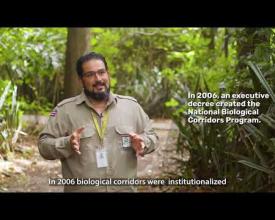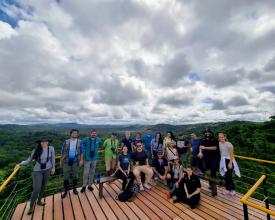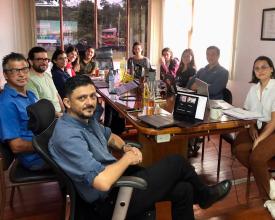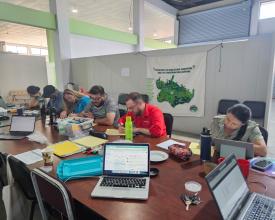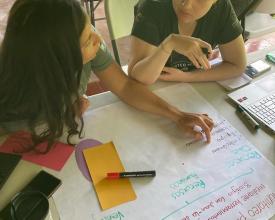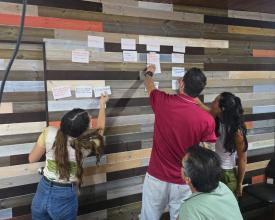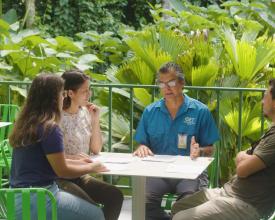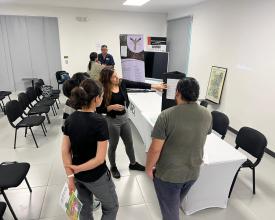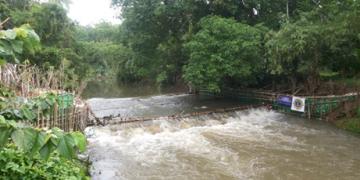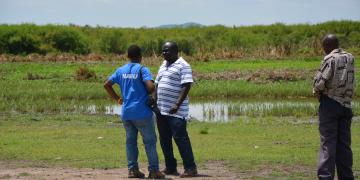
Shifting from conservation to a comprehensive approach - Biological Corridors as an effective solution to scaling up EbA measures
In Costa Rica, climate change and biodiversity strategies are closely interrelated and contribute to the country's commitments to international agendas. Biological Corridors used to focus solely on conservation, supporting multisectoral dialogue as a key to successful recovery and sustainable use of biodiversity. With the technical support of the EbA LAC Program, two Biological Corridors have become platforms for not only for conservation but for combining conservation and climate adaptation by scaling up effective ecosystem-based adaptation measures.
Year after year, floods and droughts increase, causing serious damage to infrastructure, property, and people's health, severely affecting rural communities. The need to implement adaptation measures to counteract this trend is urgent. Biological corridors with improved skills are able to elevate successful one-off projects into larger-scale initiatives that contribute to the resilience of people and ecosystems.
Contexto
Défis à relever
Agro-landscapes dominate this rural area, with livestock herders, crop growers, and tourism providers facing increasing financial losses from climate-related disasters. As the effects of climate change increase, these losses will rise exponentially. Ecosystems, vital for human activities, have been further damaged by unsustainable practices and overexploitation and struggle to recover from floods and droughts, which cause water shortages, harm communities, and threaten food security.
Ecosystem-based Adaptation (EbA) measures, solutions targeting both ecosystem restoration and climate risks, are already implemented in individual cases, but lack the structures for upscaling.
Local committees, the local governance structures of biological corridors in Costa Rica, previously focused primarily on conservation issues. They lacked the capacities and strategic focus on climate change and the orientation towards a more comprehensive approach focusing both on biodiversity loss and on climate change.
Ubicación
Procesar
Summary of the process
Thanks to the well-established structures of biological corridors with local committees, this solution has been able to optimize the conditions for scaling up much needed EbA measures. The first important factor is the general acceptance of the local committee to not only view their task in conserving biodiversity but to shift their role to a more integrated and comprehensive approach including climate risks and resilience into their considerations. To successfully do so, an organizational development approach was borrowed from the private sector to analyze what is needed. To actually implement large-scale and long-term adaptation measures, new capacities especially around communication and negotiation are built. Finally, on the strategic level, management plans are updated with a “climate lens”, viewing conservation activities differently but also including new adaptation measures.
Building Blocks
Shifting the role of local committees in biological corridors to a comprehensive approach
Biological corridors play a crucial role in promoting dialogue and participation among multiple stakeholders. Until now, their main focus has been on conservation activities. However, they have significant potential for scaling up Ecosystem-based Adaptation (EbA). They are integrated into the national strategy for the conservation and sustainable use of biodiversity. This strategy is supported by a Local Committee, which serves as a forum for consultation and collaborative sustainability initiatives. This committee comprises civil society organizations (CSOs), non-governmental organizations (NGOs), government institutions, and municipalities.
To maximize the effectiveness of biological corridors in scaling up EbA measures, it is essential to establish a shared understanding and agreement among stakeholders regarding their role. This involves making explicit the role of biological corridors - and each stakeholder who participates - in sustainability and climate change adaptation strategies, but also also their specific contribution to social and economic local development. The road to this common understanding requires analyzing sectorial vulnerabilities, needs, and interests, but also oportunities, competencies and capacities with potencial to tackle common issues. In addition, clarifying basic concepts of climate change, adaptation, biodiversity conservation (EbA) with a people-centered approach, using sectorial specific language and active stakeholder participation, is key for reaching a common understanding.
Enabling factors
Integration into National Policy Frameworks
Biological corridors are part of Costa Rica’s national conservation strategy, created through executive decree, mandating cross-sectoral cooperation in the public interest.
There is also alignment with the National Adaptation Plan of Costa Rics (Strategy #3), which promotes ecosystem-based adaptation (EbA) through sustainable ecosystem management.
Multistakeholder Governance and Participation
An important enabling factor is the existence of a Local Committee as a formal consultative and collaborative platform comprising civil society, NGOs, government institutions, and municipalities. There is also active stakeholder participation across sectors which is central to dialogue and implementation.
Lesson learned
Biological corridors should be understood as living organizations focused on citizen participation, with their own internal dynamics and operational and administrative processes. To channel efforts toward the efficient scaling of EbA measures, they need to create an identity, cohesion, and internal culture that allow them to address common challenges and opportunities. Applying the "climate lens" means going beyond management approaches focused strictly on conservation, instead focusing the analysis of potential impacts of sustainability actions on the quality of life of communities and individuals, especially vulnerable populations.
Using organizational development methods on Local Committees
The analysis of the organizational capacities of biological corridors as multisectoral governance mechanisms allows for the identification of opportunities for improvement and strengthening needs to enhance the scaling-up of EbA. Existing competencies and capacities in technical and soft skills are assessed to facilitate multi-stakeholder dialogue, raise awareness, train and negotiate with decision-makers, conduct political advocacy, and establish alliances. Internally, organizational processes are analyzed to identify and prioritize gaps and bottlenecks in project management and financial sustainability.
Enabling factors
An already existing governance structure needs to be in place, and its members should have an agreement on dedicating time to the upcoming process. Also, the process sould be facilitated by an expert in organisational development who selects adequate methods, prepares working sessions and guides the group.
Lesson learned
The main capacity-building measures identified were in strategic communication, negotiation with key stakeholders, project management, and access to financial resources. These are highly efficient soft skills that are usually overlooked or underrated.
Enhancing skills and knowledge to effectively implement and expand Ecosystem-based Adaptation (EbA) measures
With the results from the organizational development analysis , a contextualized capacity development program is created and implemented for each biological corridor according to its strengthening needs. This program is carried out through workshops, seminars, coaching sessions, peer-to-peer exchanges, etc.
Enabling factors
The commitment and interest of local committees and their members to actively participate in strengthening competencies and skills is an important enabling factor. This requires the capacity for self-reflection and self-criticism of organizational processes and their own participation. Linking the strengthening process to existing climate change adaptation strategies and initiatives at the local and national levels allows for a sustained process aligned with a broader strategy, which was an important step supported by the other building blocks. Aditionally, matching up with funding sources that accept project proposals with an EbA approach contribute to the success.
Lesson learned
- Link training and capacity building needs within the framework of the biological corridor's strategic planning.
- Develop on-site capacity building spaces and schedule them according to the participants' agendas. This is especially important to enhance the participation of women and youth.
-EbA project proposals should link cross-cutting themes such as gender, youth, and interculturality to enhance funding opportunities and the scope of actions
Integrating EbA into the strategic planning process of the biological corridor
A strategic and participatory planning process is conducted with the Local Committee to integrate Ecosystem-based Adaptation (EbA) into management tools. This process includes working sessions, workshops, and technical advice aimed at enhancing self-reflection among committee members about their actions within the territory.
In this context, incorporating a climate perspective into the strategic planning of a biological corridor means analyzing and redefining the mission and vision to focus on climate change responses. This involves recognizing the vulnerabilities and threats in the territory, as well as their implications for the most vulnerable groups and sectors. The goal is to establish targeted, sustained actions that positively affect the lives of individuals and communities while ensuring ecological connectivity and the provision of ecosystem services in line with productive and sustainable development in the region.
Enabling factors
DECREE 33106-MINAE establishes the role of Local Committees within the framework of the National Biological Corridors Program. These committees must have a management plan to enhance the channeling of resources and technical assistance to support their establishment. The diverse participation of stakeholders present in the territory allows for a broad perspective on the needs of groups and sectors, the expansion of the stakeholders involved, and the identification of opportunities for establishing partnerships for the effectiveness of EbA planning and upscaling.
Lesson learned
Planning must be contextualized within the current organizational capacities of the Local Corridor Committee. A starting point for strategic planning answers the question: What does a Biological Corridor do? It allows us to define its substantive functions as a platform for citizen participation that guides its present and future actions: it trains, raises awareness, communicates, articulates stakeholders, has political influence, fosters citizen participation, and manages projects. The integration of a climate perspective contextualizes a Management Plan consistent with its current organizational capacities to enhance actions that impact the quality of life for people and communities. It includes the integration of Climate Change, EbA, and Gender as strategic axes in the management of EbA projects with a gender perspective for financial sustainability.
Impacts
This solution has allowed for the Biological Corridor San Juan la Selva to have an updated management plan with a solid logical framework which targets the implementation and upscaling of EbA to enhance resilience of local communities. The local committee has put their acquired communication and negoctiation skills and established an open dialogue with previously absent stakeholders, such as the local government and representatives of the livestock holders. Local committees of other biological corridors are looking to learn from this experience, and have established peer-to-peer knowledge sharing formats.
Beneficiaries
Civil society: local committees, producer groups, development associations, ASADAS, women's and youth groups. Local governments and public institutions. Private companies: hotels, tourism agencies, restaurants, agribusiness, scientific institutions.
Global Biodiversity Framework (GBF)
Sustainable Development Goals
Story
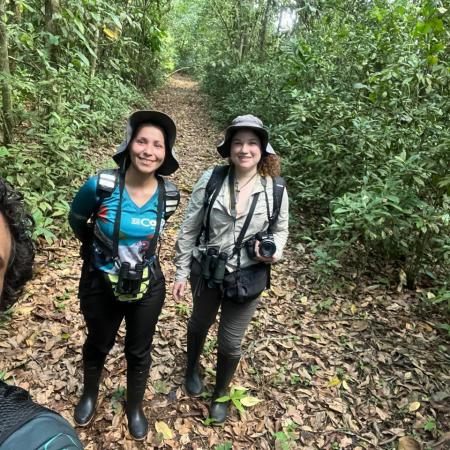
In Costa Rica, where ecosystems vibrate with the life of the Great Green Macaw and the last mountain almond trees, lies the San Juan La Selva Biological Corridor. More than a natural space, this corridor has now become a symbol of innovation and resilience in the face of climate change.
For years, this corridor has been a vital bridge between protected areas. But recently it has undergone a transformation through organizational strengthening promoted by the EbA LAC program. Thanks to this process, the Local Committee not only updated its management plan but also transformed it into a living, inclusive, and strategic tool. For the first time, climate justice and analysis of social vulnerabilities were integrated.
Fernanda Sáenz, vice president of the San Juan La Selva Biological Corridor Association, sums it up clearly: “Before, we didn't visualize many climate threats. Today, we not only understand them, but we prioritize them in our actions.”
As Fernanda described it: “For us, this process of updating the management plan has been a thorough analysis and diagnosis. It wasn't just about arriving and starting to build a management plan, but rather a process of understanding what we were doing before, what can be enhanced.” This change of mindset has allowed the acquired knowledge to expand beyond the corridor, reaching other organizations, sectors, and communities. The climate and social perspectives are now a core part of the Local Committee and its members.
This is how Ecosystem-based Adaptation (EbA) measures became tangible tools for change. Measures such as riverbank reforestation, restoration of water recharge zones, implementation of living fences, and agroecological practices are now prioritized and promoted actions to conserve biodiversity through biological connectivity.
San Juan La Selva is not just a local example. Its experience is a guide for other biological corridors. Its history demonstrates that it is possible to scale good practices, adapt strategies to diverse contexts, and build collaborative networks.
Fernanda expresses this with conviction: “Each member is here because they believe in change. We have seen the impact, and that inspires us to continue.”
Ten years from now, the dream is clear: a corridor that closes social gaps, and manages the territory with climate justice and gender equity. A space where conservation and human well-being coexist, where decisions are made based on data, vulnerability maps, and community participation.

